Microarrays, Enzymatic Assays, and MALDI-MS for Determining Specific Alterations to Mitochondrial Electron Transport Chain Activity, ROS Formation, and Lipid Composition in a Monkey Model of Parkinson’s Disease
Abstract
1. Introduction
2. Results
2.1. Density of the Mitochondrial Complex I Using [3H]-dihydrorotenone
2.2. Superoxide Formation Evoked by NADH Dehydrogenase Activity in Samples from MPTP-Treated and Control Monkeys
2.3. Superoxide Formation Evoked by Succinate Dehydrogenase Activity in Samples from MPTP-Treated and Control Monkeys
2.4. Cytochrome C Oxidase Activity in Samples from MPTP-Treated and Control Monkeys
2.5. Analysis of the Lipid Composition of Brain Areas and Tissues after MPTP Exposure
2.6. Analysis of Lipids Displaying Significant Correlations with Any of the Activities in Control and MPTP-Treated Monkeys
3. Discussion
4. Materials and Methods
4.1. Drugs and Reagents
4.2. Tissue Samples
4.3. Cell Membrane Microarray Fabrication
4.4. Autoradiography Analysis on Mitochondrial Complex I Using [3H]-DHR]
4.5. Determination of a Tissue-Specific Effect on Superoxide Formation Induced by Succinate Dehydrogenase Using the CMMAs of MPTP-Treated and Control Monkeys
4.6. Determination of Tissue-Specific Effects on Superoxide Formation Induced by Cytochrome C Oxidase Activity Using CMMAs of MPTP-Treated and Control Monkeys
4.7. MALDI-MS Lipidomic Analysis
4.8. Data Handling and Statistical Analysis
5. Conclusions
Supplementary Materials
Author Contributions
Funding
Institutional Review Board Statement
Informed Consent Statement
Data Availability Statement
Acknowledgments
Conflicts of Interest
References
- Tysnes, O.B.; Storstein, A. Epidemiology of Parkinson’s Disease. J. Neural Transm. 2017, 124, 901–905. [Google Scholar] [CrossRef] [PubMed]
- di Monte, D.A.; Lavasani, M.; Manning-Bog, A.B. Environmental Factors in Parkinson’s Disease. Neurotoxicology 2002, 23, 487–502. [Google Scholar] [CrossRef] [PubMed]
- Reeve, A.; Simcox, E.; Turnbull, D. Ageing and Parkinson’s Disease: Why Is Advancing Age the Biggest Risk Factor? Ageing Res. Rev. 2014, 14, 19–30. [Google Scholar] [CrossRef]
- Stefanis, L. α-Synuclein in Parkinson’s Disease. Cold Spring Harb. Perspect. Med. 2012, 2, a009399. [Google Scholar] [CrossRef]
- Henchcliffe, C.; Beal, F.M. Mitochondrial Biology and Oxidative Stress in Parkinson Disease Pathogenesis. Nat. Clin. Pract. Neurol. 2008, 4, 600–609. [Google Scholar] [CrossRef] [PubMed]
- Moustafa, A.A.; Chakravarthy, S.; Phillips, J.R.; Gupta, A.; Keri, S.; Polner, B.; Frank, M.J.; Jahanshahi, M. Motor Symptoms in Parkinson’s Disease: A Unified Framework. Neurosci. Biobehav. Rev. 2016, 68, 727–740. [Google Scholar] [CrossRef]
- Pfeiffer, R.F. Non-Motor Symptoms in Parkinson’s Disease. Parkinsonism Relat. Disord. 2016, 22, S119–S122. [Google Scholar] [CrossRef]
- Edwards, L.; Quigley, E.M.M.; Hofman, R.; Pfeiffer, R.F. Gastrointestinal Symptoms in Parkinson Disease: 18-Month Follow-up Study. Mov. Disord. 1993, 8, 83–86. [Google Scholar] [CrossRef]
- Haelterman, N.A.; Yoon, W.H.; Sandoval, H.; Jaiswal, M.; Shulman, J.M.; Bellen, H.J. A Mitocentric View of Parkinson’s Disease. Annu. Rev. Neurosci. 2014, 37, 137–159. [Google Scholar] [CrossRef]
- Przedborski, S.; Vila, M. The Last Decade in Parkinson’s Disease Research. Basic Sciences. Adv. Neurol. 2001, 86, 177–186. Available online: https://pubmed.ncbi.nlm.nih.gov/11553976/ (accessed on 25 December 2022).
- Sharma, L.; Lu, J.; Bai, Y. Mitochondrial Respiratory Complex I: Structure, Function and Implication in Human Diseases. Curr. Med. Chem. 2009, 16, 1266–1277. [Google Scholar] [CrossRef]
- Lipina, C.; Irving, A.J.; Hundal, H.S. Mitochondria: A Possible Nexus for the Regulation of Energy Homeostasis by the Endocannabinoid System? Am. J. Physiol. Endocrinol. Metab. 2014, 307, E1–E13. [Google Scholar] [CrossRef]
- Rich, P.R.; Maréchal, A. The Mitochondrial Respiratory Chain. Essays Biochem. 2010, 47, 1–23. [Google Scholar] [CrossRef] [PubMed]
- Smith, R.A.J.; Hartley, R.C.; Cochemé, H.M.; Murphy, M.P. Mitochondrial Pharmacology. Trends Pharmacol. Sci. 2012, 33, 341–352. [Google Scholar] [CrossRef] [PubMed]
- Tzameli, I. The Evolving Role of Mitochondria in Metabolism. Trends Endocrinol. Metab. 2012, 23, 417–419. [Google Scholar] [CrossRef]
- Grimm, S. Respiratory Chain Complex II as General Sensor for Apoptosis. Biochim. Biophys. Acta 2013, 1827, 565–572. [Google Scholar] [CrossRef] [PubMed]
- Covian, R.; Trumpower, B.L. Regulatory Interactions between Ubiquinol Oxidation and Ubiquinone Reduction Sites in the Dimeric Cytochrome Bc1 Complex. J. Biol. Chem. 2006, 281, 30925–30932. [Google Scholar] [CrossRef]
- Xia, D.; Esser, L.; Tang, W.K.; Zhou, F.; Zhou, Y.; Yu, L.; Yu, C.A. Structural Analysis of Cytochrome Bc1 Complexes: Implications to the Mechanism of Function. Biochim. Biophys. Acta 2013, 1827, 1278–1294. [Google Scholar] [CrossRef]
- Okuno, D.; Iino, R.; Noji, H. Rotation and Structure of FoF1-ATP Synthase. J. Biochem. 2011, 149, 655–664. [Google Scholar] [CrossRef]
- Oyewole, A.O.; Birch-Machin, M.A. Mitochondria-Targeted Antioxidants. FASEB J. 2015, 29, 4766–4771. [Google Scholar] [CrossRef] [PubMed]
- Yang, B.; Chen, Y.; Shi, J. Reactive Oxygen Species (ROS)-Based Nanomedicine. Chem. Rev. 2019, 119, 4881–4985. [Google Scholar] [CrossRef]
- Hekimi, S.; Wang, Y.; Noë, A. Mitochondrial ROS and the Effectors of the Intrinsic Apoptotic Pathway in Aging Cells: The Discerning Killers! Front. Genet. 2016, 7, 161. [Google Scholar] [CrossRef] [PubMed]
- Maria Michel, T.; Pulschen, D.; Thome, J. The Role of Oxidative Stress in Depressive Disorders. Curr. Pharm. Des. 2012, 18, 5890–5899. [Google Scholar] [CrossRef] [PubMed]
- Masselli, E.; Pozzi, G.; Vaccarezza, M.; Mirandola, P.; Galli, D.; Vitale, M.; Carubbi, C.; Gobbi, G. ROS in Platelet Biology: Functional Aspects and Methodological Insights. Int. J. Mol. Sci. 2020, 21, 4866. [Google Scholar] [CrossRef] [PubMed]
- Jenner, P.; Olanow, C.W. Oxidative Stress and the Pathogenesis of Parkinson’s Disease. Neurology 1996, 47, 161S–170S. [Google Scholar] [CrossRef]
- Dias, V.; Junn, E.; Mouradian, M.M. The Role of Oxidative Stress in Parkinson’s Disease. J. Parkinsons Dis. 2013, 3, 461. [Google Scholar] [CrossRef]
- Sofic, E.; Lange, K.W.; Jellinger, K.; Riederer, P. Reduced and Oxidized Glutathione in the Substantia Nigra of Patients with Parkinson’s Disease. Neurosci. Lett. 1992, 142, 128–130. [Google Scholar] [CrossRef]
- Sian, J.; Dexter, D.T.; Lees, A.J.; Daniel, S.; Agid, Y.; Javoy-Agid, F.; Jenner, P.; Marsden, C.D. Alterations in Glutathione Levels in Parkinson’s Disease and Other Neurodegenerative Disorders Affecting Basal Ganglia. Ann. Neurol. 1994, 36, 348–355. [Google Scholar] [CrossRef]
- Brandt, U. Energy Converting NADH:Quinone Oxidoreductase (Complex I). Annu. Rev. Biochem. 2006, 75, 69–92. [Google Scholar] [CrossRef]
- Schapira, A.H.V. Evidence for Mitochondrial Dysfunction in Parkinson’s Disease—A Critical Appraisal. Mov. Disord. 1994, 9, 125–138. [Google Scholar] [CrossRef]
- McCall, T.; Vallance, P. Nitric Oxide Takes Centre-Stage with Newly Defined Roles. Trends Pharmacol. Sci. 1992, 13, 1–6. [Google Scholar] [CrossRef]
- Aquilano, K.; Baldelli, S.; Rotilio, G.; Ciriolo, M.R. Role of Nitric Oxide Synthases in Parkinson’s Disease: A Review on the Antioxidant and Anti-Inflammatory Activity of Polyphenols. Neurochem. Res. 2008, 33, 2416–2426. [Google Scholar] [CrossRef] [PubMed]
- Martins-Pinge, M.C.; de Jager, L.; de Campos, B.H.; Bezerra, L.O.; Turini, P.G.; Pinge-Filho, P. Nitric Oxide Involvement in Cardiovascular Dysfunctions of Parkinson Disease. Front. Pharmacol. 2022, 13, 2660. [Google Scholar] [CrossRef]
- Li, N.; Ragheb, K.; Lawler, G.; Sturgis, J.; Rajwa, B.; Melendez, J.A.; Robinson, J.P. Mitochondrial Complex I Inhibitor Rotenone Induces Apoptosis through Enhancing Mitochondrial Reactive Oxygen Species Production. J. Biol. Chem. 2003, 278, 8516–8525. [Google Scholar] [CrossRef] [PubMed]
- Novikova, L.; Garris, B.L.; Garris, D.R.; Lau, Y.S. Early Signs of Neuronal Apoptosis in the Substantia Nigra Pars Compacta of the Progressive Neurodegenerative Mouse 1-Methyl-4-Phenyl-1,2,3,6-Tetrahydropyridine/Probenecid Model of Parkinson’s Disease. Neuroscience 2006, 140, 67–76. [Google Scholar] [CrossRef]
- Higgins, D.S.; Greenamyre, J.T. [3H]Dihydrorotenone Binding to NADH: Ubiquinone Reductase (Complex I) of the Electron Transport Chain: An Autoradiographic Study. J. Neurosci. 1996, 16, 3807. [Google Scholar] [CrossRef]
- Winklhofer, K.F.; Haass, C. Mitochondrial Dysfunction in Parkinson’s Disease. Biochim. Biophys. Acta 2010, 1802, 29–44. [Google Scholar] [CrossRef]
- Exner, N.; Lutz, A.K.; Haass, C.; Winklhofer, K.F. Mitochondrial Dysfunction in Parkinson’s Disease: Molecular Mechanisms and Pathophysiological Consequences. EMBO J. 2012, 31, 3038–3062. [Google Scholar] [CrossRef]
- Perier, C.; Vila, M. Mitochondrial Biology and Parkinson’s Disease. Cold Spring Harb. Perspect. Med. 2012, 2, a009332. [Google Scholar] [CrossRef] [PubMed]
- Porter, R.H.P.; Greene, J.G.; Higgins, D.S.; Greenamyre, J.T. Polysynaptic Regulation of Glutamate Receptors and Mitochondrial Enzyme Activities in the Basal Ganglia of Rats with Unilateral Dopamine Depletion. J. Neurosci. 1994, 14, 7192. [Google Scholar] [CrossRef]
- Chiken, S.; Hatanaka, N.; Tokuno, H. Cytochrome Oxidase Activity in the Monkey Globus Pallidus and Subthalamic Nucleus after Ablation of Striatal Interneurons Expressing Substance P Receptors. Neurosci. Lett. 2003, 353, 103–106. [Google Scholar] [CrossRef]
- Vila, M.; Levy, R.; Herrero, M.T.; Faucheux, B.; Obeso, J.A.; Agid, Y.; Hirsch, E.C. Metabolic Activity of the Basal Ganglia in Parkinsonian Syndromes in Human and Non-Human Primates: A Cytochrome Oxidase Histochemistry Study. Neuroscience 1996, 71, 903–912. [Google Scholar] [CrossRef] [PubMed]
- Hattori, N.; Mizuno, Y. Mitochondrial Dysfunction in Parkinson’s Disease. Exp. Neurobiol. 2015, 24, 103. [Google Scholar] [CrossRef]
- Fais, M.; Dore, A.; Galioto, M.; Galleri, G.; Crosio, C.; Iaccarino, C. Parkinson’s Disease-Related Genes and Lipid Alteration. Int. J. Mol. Sci. 2021, 22, 7630. [Google Scholar] [CrossRef] [PubMed]
- Alcalay, R.N.; Hsieh, F.; Tengstrand, E.; Padmanabhan, S.; Baptista, M.; Kehoe, C.; Narayan, S.; Boehme, A.K.; Merchant, K. Higher Urine Bis(Monoacylglycerol)Phosphate Levels in LRRK2 G2019S Mutation Carriers: Implications for Therapeutic Development. Mov. Disord. 2020, 35, 134–141. [Google Scholar] [CrossRef]
- Miranda, A.M.; di Paolo, G. Endolysosomal Dysfunction and Exosome Secretion: Implications for Neurodegenerative Disorders. Cell Stress 2018, 2, 115–118. [Google Scholar] [CrossRef] [PubMed]
- Fabelo, N.; Martín, V.; Santpere, G.; Marín, R.; Torrent, L.; Ferrer, I.; Díaz, M. Severe Alterations in Lipid Composition of Frontal Cortex Lipid Rafts from Parkinson’s Disease and Incidental Parkinson’s Disease. Mol. Med. 2011, 17, 1107–1118. [Google Scholar] [CrossRef] [PubMed]
- Canerina-Amaro, A.; Pereda, D.; Diaz, M.; Rodriguez-Barreto, D.; Casañas-Sánchez, V.; Heffer, M.; Garcia-Esparcia, P.; Ferrer, I.; Puertas-Avendaño, R.; Marin, R. Differential Aggregation and Phosphorylation of Alpha Synuclein in Membrane Compartments Associated with Parkinson Disease. Front. Neurosci. 2019, 13, 382. [Google Scholar] [CrossRef]
- Liu, W.; Jalewa, J.; Sharma, M.; Li, G.; Li, L.; Hölscher, C. Neuroprotective Effects of Lixisenatide and Liraglutide in the 1-Methyl-4-Phenyl-1,2,3,6-Tetrahydropyridine Mouse Model of Parkinson’s Disease. Neuroscience 2015, 303, 42–50. [Google Scholar] [CrossRef]
- Fünfgeld, E.W.; Baggen, M.; Nedwidek, P.; Richstein, B.; Mistlberger, G. Double-Blind Study with Phosphatidylserine (PS) in Parkinsonian Patients with Senile Dementia of Alzheimer’s Type (SDAT). Prog. Clin. Biol. Res. 1989, 317, 1235–1246. [Google Scholar] [CrossRef]
- Burger, M.E.; Alves, A.; Callegari, L.; Athayde, F.R.; Nogueira, C.W.; Zeni, G.; Rocha, J.B.T. Ebselen Attenuates Reserpine-Induced Orofacial Dyskinesia and Oxidative Stress in Rat Striatum. Prog. Neuropsychopharmacol. Biol. Psychiatry 2003, 27, 135–140. [Google Scholar] [CrossRef] [PubMed]
- Perry, J.C.; da Cunha, C.; Anselmo-Franci, J.; Andreatini, R.; Miyoshi, E.; Tufik, S.; Vital, M.A.B.F. Behavioural and Neurochemical Effects of Phosphatidylserine in MPTP Lesion of the Substantia Nigra of Rats. Eur. J. Pharmacol. 2004, 484, 225–233. [Google Scholar] [CrossRef]
- Yang, S.; Lian, G. ROS and Diseases: Role in Metabolism and Energy Supply. Mol. Cell Biochem. 2020, 467, 1–12. [Google Scholar] [CrossRef] [PubMed]
- Lambeth, J.D. NOX Enzymes and the Biology of Reactive Oxygen. Nat. Rev. Immunol. 2004, 4, 181–189. [Google Scholar] [CrossRef] [PubMed]
- Youdim, M.B.H.; Edmondson, D.; Tipton, K.F. The Therapeutic Potential of Monoamine Oxidase Inhibitors. Nat. Rev. Neurosci. 2006, 7, 295–309. [Google Scholar] [CrossRef]
- Brieger, K.; Schiavone, S.; Miller, F.J.; Krause, K.H. Reactive Oxygen Species: From Health to Disease. Swiss Med. Wkly. 2012, 142, w13659. [Google Scholar] [CrossRef] [PubMed]
- Filomeni, G.; de Zio, D.; Cecconi, F. Oxidative Stress and Autophagy: The Clash between Damage and Metabolic Needs. Cell Death Differ. 2015, 22, 377. [Google Scholar] [CrossRef]
- Schulze, H.; Sandhoff, K. Sphingolipids and Lysosomal Pathologies. Biochim. Biophys. Acta (BBA)-Mol. Cell Biol. Lipids 2014, 1841, 799–810. [Google Scholar] [CrossRef]
- Manuel, I.; Barreda-Gomez, G.; González De San Román, E.; Veloso, A.; Fernández, J.A.; Giralt, M.T.; Rodriguez-Puertas, R. Neurotransmitter Receptor Localization: From Autoradiography to Imaging Mass Spectrometry. ACS Chem. Neurosci. 2015, 6, 362–373. [Google Scholar] [CrossRef]
- Hebert-Chatelain, E.; Desprez, T.; Serrat, R.; Bellocchio, L.; Soria-Gomez, E.; Busquets-Garcia, A.; Pagano Zottola, A.C.; Delamarre, A.; Cannich, A.; Vincent, P.; et al. A Cannabinoid Link between Mitochondria and Memory. Nature 2016, 539, 555–559. [Google Scholar] [CrossRef]
- Fernández, R.; Garate, J.; Tolentino-Cortez, T.; Herraiz, A.; Lombardero, L.; Ducrocq, F.; Rodríguez-Puertas, R.; Trifilieff, P.; Astigarraga, E.; Barreda-Gómez, G.; et al. Microarray and Mass Spectrometry-Based Methodology for Lipid Profiling of Tissues and Cell Cultures. Anal. Chem. 2019, 91, 15967–15973. [Google Scholar] [CrossRef] [PubMed]
- Pereiro, X.; Fernández, R.; Barreda-Gómez, G.; Ruzafa, N.; Acera, A.; Araiz, J.; Astigarraga, E.; Vecino, E. Comparative Lipidomic Analysis of Mammalian Retinal Ganglion Cells and Müller Glia in Situ and in Vitro Using High-Resolution Imaging Mass Spectrometry. Sci. Rep. 2020, 10, 20053. [Google Scholar] [CrossRef] [PubMed]
- Bradford, M.M. A Rapid and Sensitive Method for the Quantitation of Microgram Quantities of Protein Utilizing the Principle of Protein-Dye Binding. Anal. Biochem. 1976, 72, 248–254. [Google Scholar] [CrossRef]
- Sánchez-Magraner, L.; de La Fuente, M.; Evans, C.; Miles, J.; Elexpe, A.; Rodriguez-Astigarraga, M.; Astigarraga, E.; Barreda-Gómez, G.; Samanidou, V.; Mandrioli, R.; et al. Quantification of PD-1/PD-L1 Interaction between Membranes from PBMCs and Melanoma Samples Using Cell Membrane Microarray and Time-Resolved Förster Resonance Energy Transfer. Analytica 2021, 2, 156–170. [Google Scholar] [CrossRef]
- Elexpe, A.; Nieto, N.; Fernández-Cuétara, C.; Domínguez-Fernández, C.; Morera-Herreras, T.; Torrecilla, M.; Miguélez, C.; Laso, A.; Ochoa, E.; Bailen, M.; et al. Study of Tissue-Specific Reactive Oxygen Species Formation by Cell Membrane Microarrays for the Characterization of Bioactive Compounds. Membranes 2021, 11, 943. [Google Scholar] [CrossRef]
- Puertas, R.R.; Gomez, G.B.; Rue, M.T.G.; Pastor, B.F. Method of Quantifying the g Protein-Coupled Receptor (Gpcr)/g Protein Coupling Using a Cell Membrane Array. U.S. Patent 8,017,346, 28 July 2006. [Google Scholar]
- Unnerstall, J.R.; Niehoff, D.L.; Kuhar, M.J.; Palacios, J.M. Quantitative Receptor Autoradiography Using [3H] Ultrofilm: Application to Multiple Benzodiazepine Receptors. J. Neurosci. Methods 1982, 6, 59–73. [Google Scholar] [CrossRef]
- Astigarraga, E.; Barreda-Gómez, G.; Lombardero, L.; Fresnedo, O.; Castaño, F.; Giralt, M.T.; Ochoa, B.; Rodríguez-Puertas, R.; Fernández, J.A. Profiling and Imaging of Lipids on Brain and Liver Tissue by Matrix-Assisted Laser Desorption/ Ionization Mass Spectrometry Using 2-Mercaptobenzothiazole as a Matrix. Anal. Chem. 2008, 80, 9105–9114. [Google Scholar] [CrossRef] [PubMed]

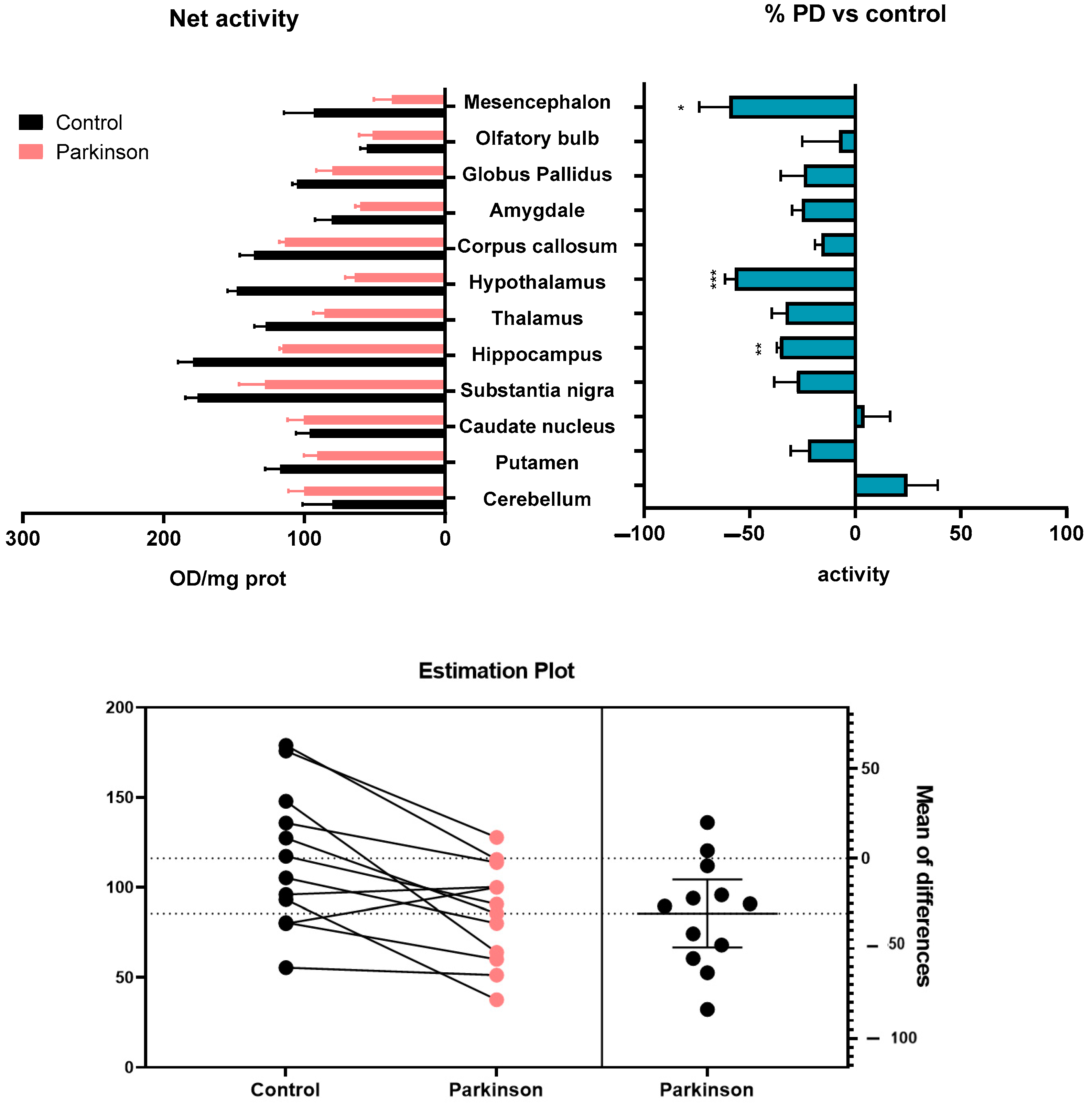

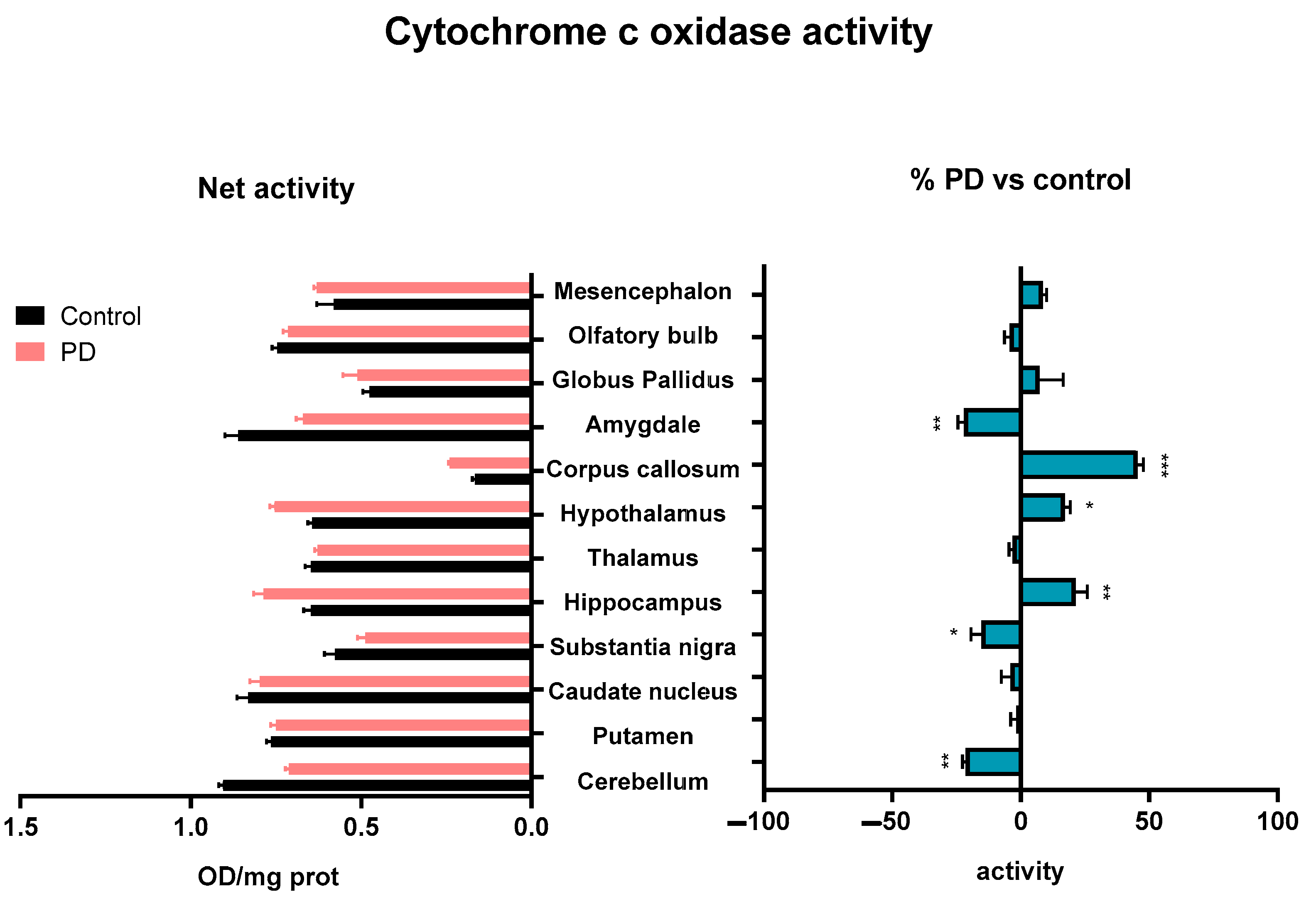
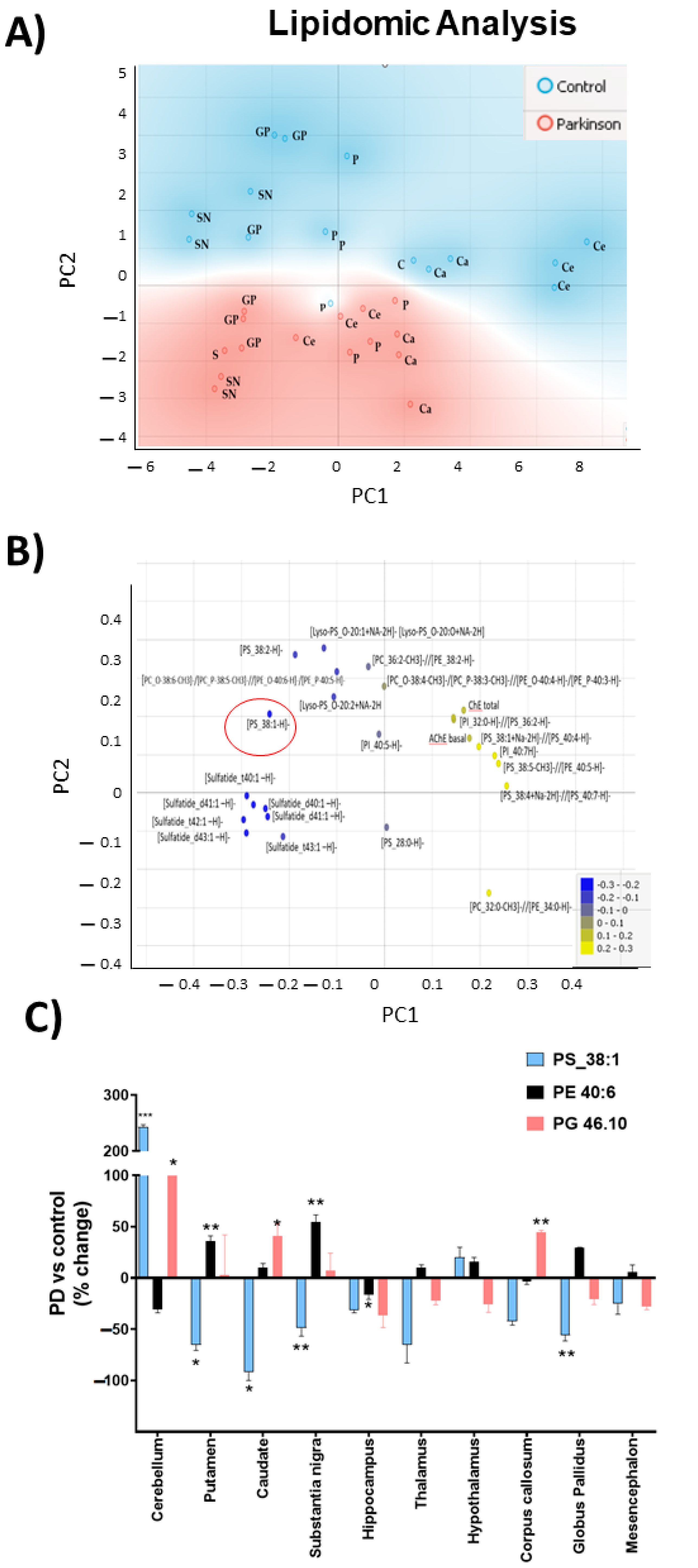
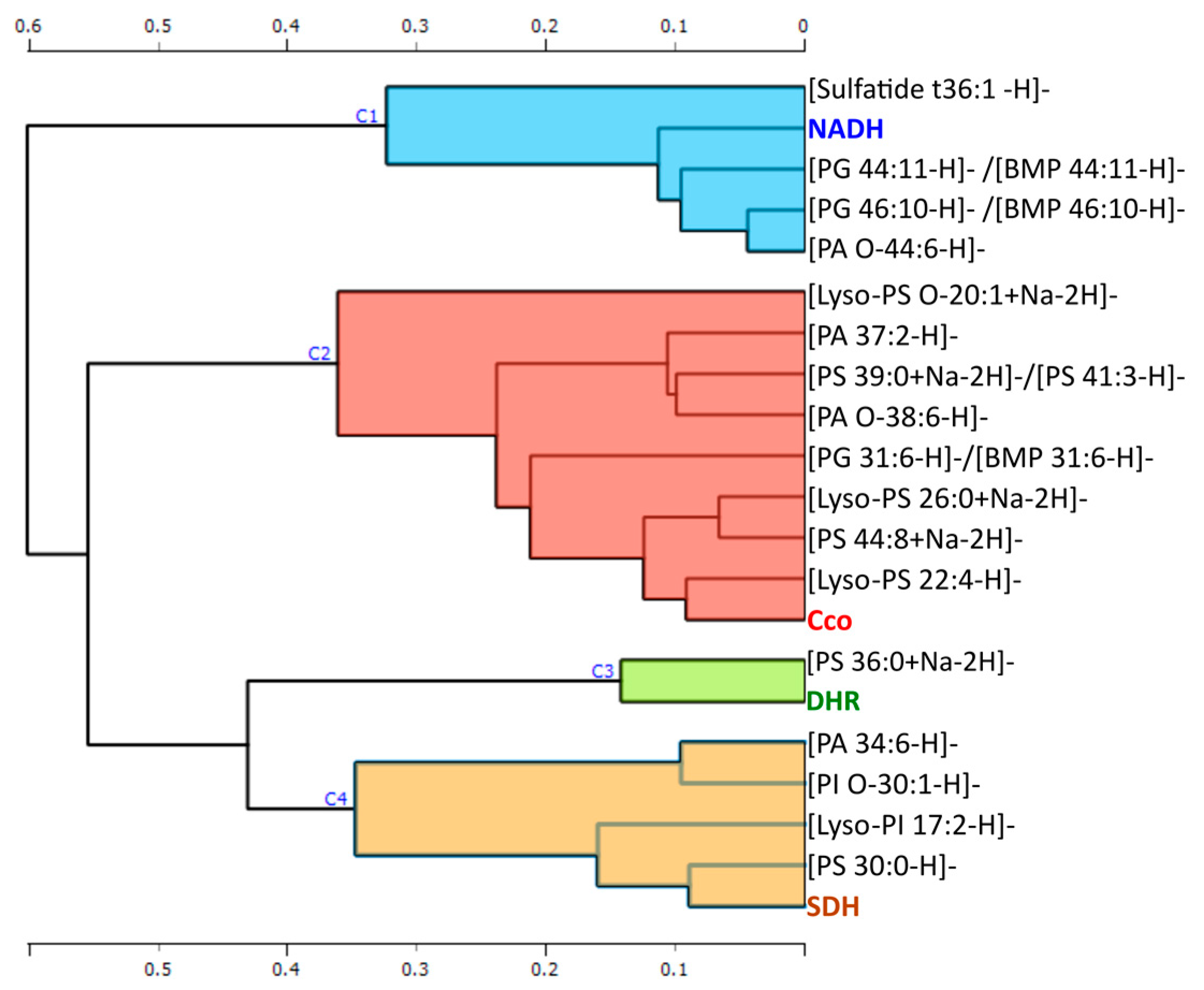
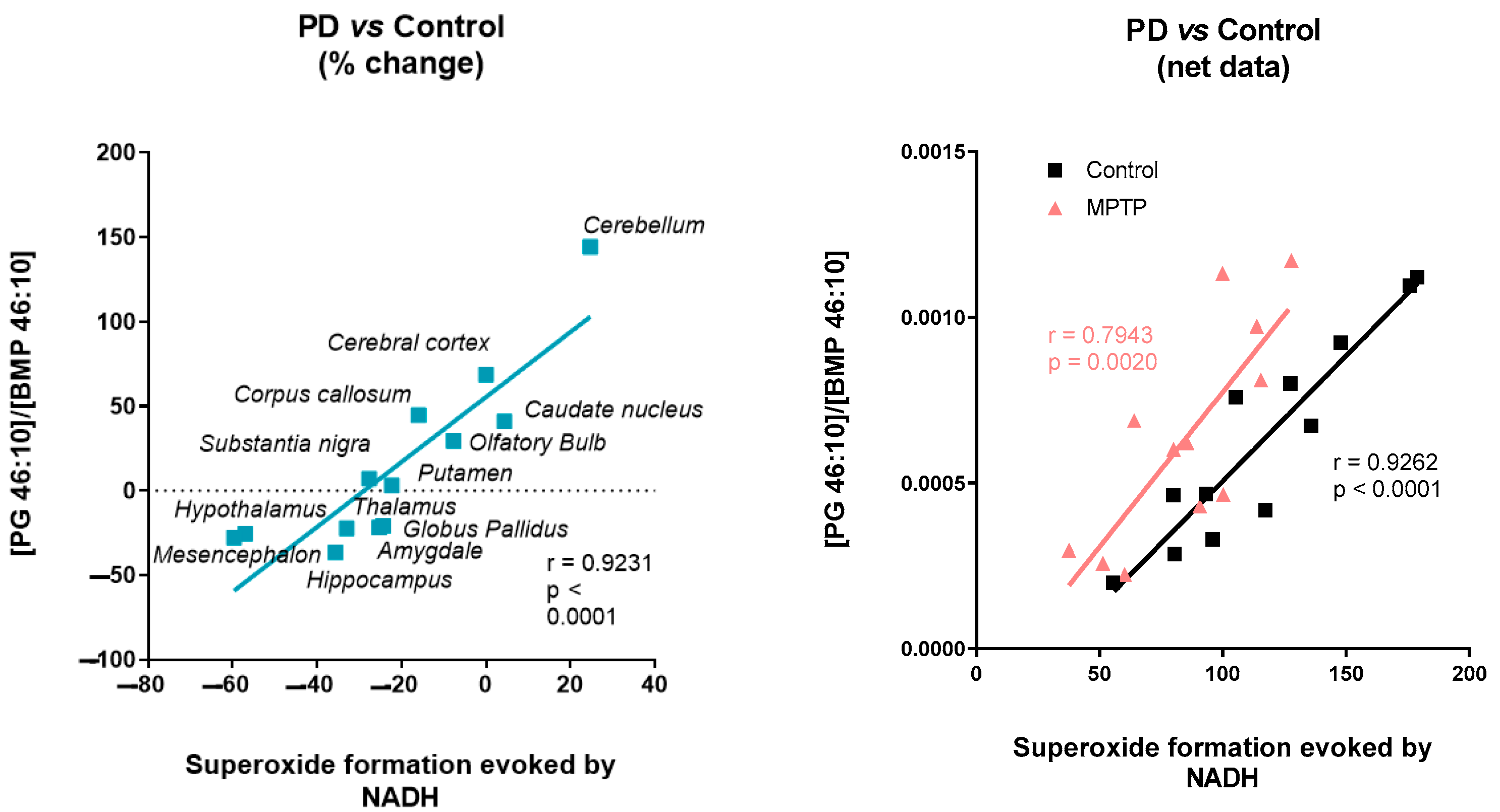
Disclaimer/Publisher’s Note: The statements, opinions and data contained in all publications are solely those of the individual author(s) and contributor(s) and not of MDPI and/or the editor(s). MDPI and/or the editor(s) disclaim responsibility for any injury to people or property resulting from any ideas, methods, instructions or products referred to in the content. |
© 2023 by the authors. Licensee MDPI, Basel, Switzerland. This article is an open access article distributed under the terms and conditions of the Creative Commons Attribution (CC BY) license (https://creativecommons.org/licenses/by/4.0/).
Share and Cite
García-Fernández, M.D.; Larrea, A.; Fernández, R.; Rodríguez-Puertas, R.; Astigarraga, E.; Manuel, I.; Barreda-Gómez, G. Microarrays, Enzymatic Assays, and MALDI-MS for Determining Specific Alterations to Mitochondrial Electron Transport Chain Activity, ROS Formation, and Lipid Composition in a Monkey Model of Parkinson’s Disease. Int. J. Mol. Sci. 2023, 24, 5470. https://doi.org/10.3390/ijms24065470
García-Fernández MD, Larrea A, Fernández R, Rodríguez-Puertas R, Astigarraga E, Manuel I, Barreda-Gómez G. Microarrays, Enzymatic Assays, and MALDI-MS for Determining Specific Alterations to Mitochondrial Electron Transport Chain Activity, ROS Formation, and Lipid Composition in a Monkey Model of Parkinson’s Disease. International Journal of Molecular Sciences. 2023; 24(6):5470. https://doi.org/10.3390/ijms24065470
Chicago/Turabian StyleGarcía-Fernández, María Dolores, Ane Larrea, Roberto Fernández, Rafael Rodríguez-Puertas, Egoitz Astigarraga, Iván Manuel, and Gabriel Barreda-Gómez. 2023. "Microarrays, Enzymatic Assays, and MALDI-MS for Determining Specific Alterations to Mitochondrial Electron Transport Chain Activity, ROS Formation, and Lipid Composition in a Monkey Model of Parkinson’s Disease" International Journal of Molecular Sciences 24, no. 6: 5470. https://doi.org/10.3390/ijms24065470
APA StyleGarcía-Fernández, M. D., Larrea, A., Fernández, R., Rodríguez-Puertas, R., Astigarraga, E., Manuel, I., & Barreda-Gómez, G. (2023). Microarrays, Enzymatic Assays, and MALDI-MS for Determining Specific Alterations to Mitochondrial Electron Transport Chain Activity, ROS Formation, and Lipid Composition in a Monkey Model of Parkinson’s Disease. International Journal of Molecular Sciences, 24(6), 5470. https://doi.org/10.3390/ijms24065470





